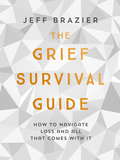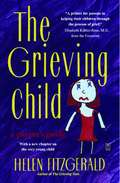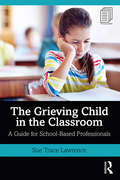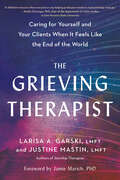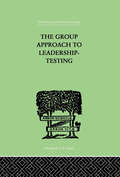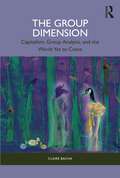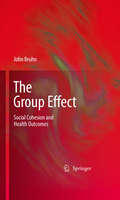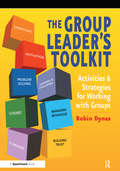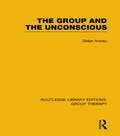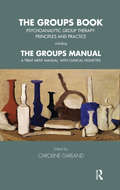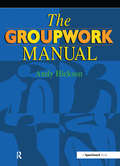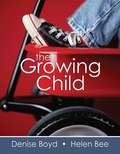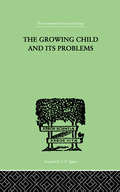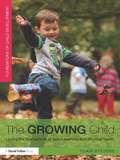- Table View
- List View
The Grief Recovery Handbook, 20th Anniversary Expanded Edition: The Action Program for Moving Beyond Death, Divorce, and Other Losses including Health, Career, and Faith
by John W. James Russell FriedmanNewly updated and expanded to commemorate its twentieth anniversary--this classic resource helps people complete the grieving process and move toward recovery and happiness.Incomplete recovery from grief can have a lifelong negative effect on the capacity for happiness. Drawing from their own histories as well as from others', the authors illustrate how it is possible to recover from grief and regain energy and spontaneity. Based on a proven program, The Grief Recovery Handbook offers grievers the specific actions needed to move beyond loss. New material in this edition includes guidance for dealing with: Loss of faith Loss of career and financial issues Loss of health Growing up in an alcoholic or dysfunctional home
The Grief Survival Guide: How to navigate loss and all that comes with it
by Jeff BrazierJeff Brazier has experienced bereavement in many forms: In his childhood, helping his two boys through the devastating death of their mother, Jade Goody, witnessing the anguish of his own mum when she lost both of her parents, and hearing the stories of his coaching clients who are coming to terms with loss. No one can be an expert on grief, but within this book Jeff provides support and guidance from someone who has been there. Accessible and hands-on The Grief Survival Guide offers practical advice on everything from preparing for the eventuality of death, managing grief, how best to support family and friends, and moving forward. There is no 'one size fits all' approach so instead Jeff teaches us that the best we can do is understand, cope and survive.
The Grief Survival Guide: How to navigate loss and all that comes with it
by Jeff BrazierJeff Brazier has experienced bereavement in many forms: In his childhood, helping his two boys through the devastating death of their mother, Jade Goody, witnessing the anguish of his own mum when she lost both of her parents, and hearing the stories of his coaching clients who are coming to terms with loss. No one can be an expert on grief, but within this book Jeff provides support and guidance from someone who has been there. Accessible and hands-on The Grief Survival Guide offers practical advice on everything from preparing for the eventuality of death, managing grief, how best to support family and friends, and moving forward. There is no 'one size fits all' approach so instead Jeff teaches us that the best we can do is understand, cope and survive.
The Grief Survival Guide: How to navigate loss and all that comes with it
by Jeff BrazierA practical guide to navigating grief and everything that comes with loss.Jeff Brazier has experienced bereavement in many forms: In his childhood, helping his two boys through the devastating death of their mother, Jade Goody, witnessing the anguish of his own mum when she lost both of her parents, and hearing the stories of his coaching clients who are coming to terms with loss. No one can be an expert on grief, but within this book Jeff provides support and guidance from someone who has been there. Accessible and hands-on The Grief Survival Guide offers practical advice on everything from preparing for the eventuality of death, managing grief, how best to support family and friends, and moving forward. There is no 'one size fits all' approach so instead Jeff teaches us that the best we can do is understand, cope and survive.(P)2017 Hodder & Stoughton Limited
The Grieving Body: How the Stress of Loss Can Be an Opportunity for Healing
by Mary-Frances O'ConnorThe follow-up to celebrated grief expert, neuroscientist, and psychologist Dr. Mary-Frances O’Connor’s The Grieving Brain focuses on the impact of grief—and life’s other major stressors—on the human body. Coping with death and grief is one of the most painful human experiences. While we can speak to the psychological and emotional ramifications of loss and sorrow, we often overlook its impact on our physical bodies. Dr. Mary-Frances O’Connor specializes in the study of grief, and in The Grieving Body she shares vital scientific research, revealing imperative new insights on its profound physiological impact. As she did in The Grieving Brain, O’Connor combines illuminating studies and personal stories to explore the toll loss takes on our cardiovascular, endocrine, and immune systems and the larger implications for our long-term well-being.The Grieving Body addresses questions about how bereavement affects us, such as:Can we die of a broken heart?What happens in our bodies when we’re grieving?How do our coping behaviors affect our physical health?What is the cognitive impact of grief?Why are we more prone to illness during times of enormous stress?and moreResearch-backed, warm, and empathetic, The Grieving Body is an essential, hopeful read for those experiencing loss as well as their supportive friends and family.The Grieving Body is illustrated with black-and-white charts and graphs.
The Grieving Brain: The Surprising Science of How We Learn from Love and Loss
by Mary-Frances O'ConnorA renowned grief expert and neuroscientist shares groundbreaking discoveries about what happens in our brain when we grieve, providing a new paradigm for understanding love, loss, and learning.For as long as humans have existed, we have struggled when a loved one dies. Poets and playwrights have written about the dark cloak of grief, the deep yearning, how devastating heartache feels. But until now, we have had little scientific perspective on this universal experience. In The Grieving Brain, neuroscientist and psychologist Mary-Frances O’Connor, PhD, gives us a fascinating new window into one of the hallmark experiences of being human. O’Connor has devoted decades to researching the effects of grief on the brain, and in this book, she makes cutting-edge neuroscience accessible through her contagious enthusiasm, and guides us through how we encode love and grief. With love, our neurons help us form attachments to others; but, with loss, our brain must come to terms with where our loved ones went, or how to imagine a future that encompasses their absence. Based on O’Connor’s own trailblazing neuroimaging work, research in the field, and her real-life stories, The Grieving Brain does what the best popular science books do, combining storytelling, accessible science, and practical knowledge that will help us better understand what happens when we grieve and how to navigate loss with more ease and grace.
The Grieving Child
by Helen FitzgeraldMaking a Child's World Whole Again Explaining death to a child is one of the most difficult tasks a parent or other relative can face. The Grieving Child offers practical, compassionate advice for helping a child cope with the death of a parent or other loved one. Parents of children from preschool age to the teen years will find much-needed guidance, covering: Helping a child visit the seriously ill or dying Using language appropriate to a child's age level Selecting useful books about death Handling especially difficult situations, including murder and suicide Deciding whether a child should attend a funeral With a new chapter devoted to the special issues of the bereaved toddler, The Grieving Child provides invaluable suggestions for dealing with a child's emotional responses (including anger, guilt, and depression) and helping a child adjust to a new life.
The Grieving Child in the Classroom: A Guide for School-Based Professionals
by Sue Trace LawrenceThe Grieving Child in the Classroom integrates the latest research on children’s bereavement and adapts it for use in the classroom. Chapters tackle the neurological, cognitive, emotional, and social effects of childhood grief and demonstrate the ways in which those reactions can manifest in the classroom. By recognizing individual differences in coping styles and considering variables such as developmental stage, nature of the loss, and availability of support, teachers and staff can become better equipped to respond to the bereaved child’s needs. The book incorporates theoretical explanations of grief responses as well as practical suggestions for supporting bereaved children in real-world settings. Whether the loss affects one child or the entire student body, educators can turn to this comprehensive guidebook for ways to support grieving students in their classrooms.
The Grieving Child: A Parent's Guide
by Helen FitzgeraldMaking a Child's World Whole Again Explaining death to a child is one of the most difficult tasks a parent or other relative can face. The Grieving Child offers practical, compassionate advice for helping a child cope with the death of a parent or other loved one. Parents of children from preschool age to the teen years will find much-needed guidance, covering: Helping a child visit the seriously ill or dying Using language appropriate to a child's age level Selecting useful books about death Handling especially difficult situations, including murder and suicide Deciding whether a child should attend a funeral With a new chapter devoted to the special issues of the bereaved toddler, The Grieving Child provides invaluable suggestions for dealing with a child's emotional responses (including anger, guilt, and depression) and helping a child adjust to a new life.
The Grieving Teen: A Guide for Teenagers and Their Friends
by Helen FitzgeraldThis book helps teenagers to understand and overcome the feelings of regret, anger, shock, and disbelief at the death of a loved one, and in doing so sets them on their way to rebuild life from the ashes of sorrow and loss.
The Grieving Therapist: Caring for Yourself and Your Clients When It Feels Like the End of the World
by Larisa A. Garski Justine MastinFor readers of No Cure for Being Human and Simple Self-Care for Therapists, a witty and compassionate field guide to the 10 realms of grief--and how to navigate them yourself and with clients. How do you practice good therapy when it&’s the end of the world as we know it…and no one feels fine?The planet is burning, friends and family are falling to cults and QAnon, and we&’re all living through the collective trauma of a global pandemic. Among therapists and healers, burnout is rampant; hopelessness and despair are, too. In The Grieving Therapist, psychotherapists Larisa Garski, LMFT, and Justine Mastin, LMFT, give voice to the difficulties of therapising in today&’s world--and offer a grief-informed framework for taking care of yourself as you take care of others. Informed by narrative, internal family systems, fanfic, and trauma-sensitive therapy, Garski and Mastin examine what it means to be a therapist at the end of the world (or what feels like it). They break down 10 realms of grief that are critical to understand and work with today, but likely weren&’t taught to you in therapy school. Each chapter includes:Grieving tools that can be adapted for both client and therapistTips for supervisors and superviseesSkills for maintaining healthy outside-the-office relationshipsSupport for current therapy students (and therapists new to the field)Advice on how to hold space and work with clients who have the same questions—and are navigating the same issues—as youMeditations on love, life, death, and connectionGarski and Mastin also share helpful guidance around working with clients whose social or political beliefs differ from yours; when therapeutic self-disclosure makes sense; honoring the information that countertransference is trying to give you; and how to sit with (or step away from) triggers in your work.With humor, compassion, irreverence, and more than a little whimsy, The Grieving Therapist shows you how to show up for yourself, and your clients--in your own full humanity, amidst it all.
The Group Approach To Leadership-Testing
by Harris, HenryFirst Published in 1999. Routledge is an imprint of Taylor & Francis, an informa company.
The Group Dimension: Capitalism, Group Analysis, and the World Yet to Come
by Claire BachaThe Group Dimension presents a thorough exploration of the history and theory of the group dimension, particularly in the context of modern capitalist society.The book traces the development of capitalism from feudalism, where the first polis groups can be identified, and describes the growth of the power of the state prescribed by John Maynard Keynes to form neoliberalism. Bacha then explores the deep history of human groups, examines how our brains are built for and by multibody interactions and understandings, and provides an overview of our knowledge of groups, building on findings from group analysis. The book concludes by exploring how an understanding of groups, their facilitation and their consciousness redefines current individualistic and autistic 'freedom', to build the new world through dialogue.The Group Dimension will be essential reading for anyone involved in groups, as practitioners or clients. It will also be of interest to readers looking to learn more about groups in the context of modern politics, social and liberation movements.
The Group Effect
by John BruhnSociologists and anthropologists have had a long interest in studying the ways in which cultures shaped different patterns of health, disease, and mortality. Social scientists have documented low rates of chronic disease and disability in non-Western societies and have suggested that social stability, cultural homogeneity and social cohesion may play a part in explaining these low rates. On the other hand, in studies of Western societies, social scientists have found that disease and mortality assume different patterns among various ethnic, cultural and social-economic groups. The role of stress, social change and a low degree of cohesion have been suggested, along with other factors as contributing to the variable rates among different social groups. Social cohesion has been implicated in the cause and recovery from both physical and psychological illnesses. Although there has been a large amount of work established the beneficial effects of cohesion on health and well-being, relatively little work has focused on HOW increased social cohesion sustains or improves health. This work is based on the premise that there are risk factors, including social cohesion that regulate health and disease in groups. One of the challenges is how to measure social cohesion - it can be readily observed and experienced but difficult to quantify. A better understanding of how social cohesion works will be valuable to improving group-level interventions.
The Group Leader's Toolkit: Activities and Strategies for Working with Groups
by Robin DynesAn essential resource for all kinds of groups, these tried and tested strategies will stimulate and encourage full participation from all group members. Provides ideas for introducing group members to each other, breaking down barriers, energising people, helping people learn, moving the group on, building trust between group members, motivating people, assessing and evaluating the group, managing behaviour and personal responsibility, and ending sessions. The activities are set out in a clear, easy to follow format, with variations and guidance for adapting the activities. Will enable group leaders to promote group members' self development, meet the needs of their different learning styles, stimulate their creativity and develop their thinking skills. This toolkit is an invaluable resource for tutors, occupational therapists, nurses, care staff, probation staff, youth leaders or anyone - new or experienced - who works with groups.
The Group Therapist's Notebook: Homework, Handouts, and Activities for Use in Psychotherapy
by Dawn ViersFollowing in the footsteps of the successful first edition, The Group Therapist’s Notebook, Second Edition offers an all new collection of innovative ideas and proven interventions that will enhance any group therapy practice. Seasoned and up-and-coming experts provide field-tested activities, easy to reproduce handouts, and practical homework assignments for a variety of problems and population types. Each chapter is solidly grounded with a theoretical foundation and includes materials to gather for implementing the intervention, detailed instructions for use, suggestions for follow-up in successive meetings, contraindications for use, and resources for the client and therapist. With an added emphasis on instruction, real-world examples, and extension activities, this new resource will be a valuable asset for both beginning and established mental health practitioners, including counselor educators, social workers, marriage and family therapists, guidance counselors, prevention educators, peer support specialists, and other group facilitators.
The Group Therapy Treatment Planner
by Arthur E. Jongsma Kim PalegThe Group Therapy Treatment Planner, Second Edition provides all the elements necessary to quickly and easily develop formal treatment plans that satisfy the demands of HMOs, managed care companies, third-party payors, and state and federal review agencies. A critical tool for mental health professionals developing formal treatment plans for working with a variety of groups New edition features expanded coverage and outlines entirely new areas including utilizing group therapy to treat panic/agoraphobia, PTSD/trauma, adult ADHD, obsessive-compulsive disorder, and borderline personality disorder Streamlined interventions and fully updated language make this edition easier to use and more clinically applicable Saves you hours of time-consuming paperwork, yet offers the freedom to develop customized treatment plans Organized around 33 main presenting problems with a focus on applying a group therapy approach to a wide variety of disorders Over 1,000 well-crafted, clear statements describe the behavioral manifestations of each relational problem, long-term goals, short-term objectives, and clinically tested treatment options Easy-to-use reference format helps locate treatment plan components by behavioral problem or DSM-IV-TR diagnosis Includes a sample treatment plan that conforms to the requirements of most third-party payors and accrediting agencies (including HCFA, JCAHO, and NCQA)
The Group Therapy Treatment Planner, with DSM-5 Updates (PracticePlanners)
by Arthur E. Jongsma Jr. Kim PalegThis fully revised resource features: Treatment plan components for 33 behaviorally based presenting problems Over 1,000 prewritten treatment goals, objectives, and interventions—plus space to record your own treatment plan options A step-by-step guide to writing treatment plans that meet the requirements of most insurance companies and third-party payors The Group Therapy Treatment Planner, Second Edition provides all the elements necessary to quickly and easily develop formal treatment plans that satisfy the demands of HMOs, managed care companies, third-party payors, and state and federal review agencies. A critical tool for mental health professionals developing formal treatment plans for working with a variety of groups New edition features expanded coverage and outlines entirely new areas including utilizing group therapy to treat panic/agoraphobia, PTSD/trauma, adult ADHD, obsessive-compulsive disorder, and borderline personality disorder Streamlined interventions and fully updated language make this edition easier to use and more clinically applicable Saves you hours of time-consuming paperwork, yet offers the freedom to develop customized treatment plans Organized around 33 main presenting problems with a focus on applying a group therapy approach to a wide variety of disorders Over 1,000 well-crafted, clear statements describe the behavioral manifestations of each relational problem, long-term goals, short-term objectives, and clinically tested treatment options Easy-to-use reference format helps locate treatment plan components by behavioral problem Includes a sample treatment plan that conforms to the requirements of most third-party payors and accrediting agencies (including HCFA, JCAHO, and NCQA)
The Group and the Unconscious (Routledge Library Editions: Group Therapy)
by Didier AnzieuOriginally published in 1984, this is the first published account in English of the development of group psychotherapy in France. Under the leadership of Professor Didier Anzieu, psychoanalysts actively and ingeniously brought psychoanalytical insights to bear upon group process. These methods were widely applied in training groups for mental health professionals, as well as in many other organizations. Anzieu and his colleagues made many advances in understanding the psychology of large-group situations, and these advances contributed to the growing interest in the field. The main aim of the book is to examine the unconscious life of the human group. Professor Anzieu describes the processes of fantasy and imagination that are common to social organizations, training groups and psychotherapeutic groups, and extends the psychoanalytical theory about dreams to the group. He gives an account of the various kinds of group fantasies, such as the group illusion, the group as a mouth, breaking apart fantasies, the group-machine, and the self-destructive group. The book is illustrated by ten clinical case studies, which are vividly described by Professor Anzieu. The interaction of the imaginary processes and the social ideas of the group are also studied, and the theoretical discussion in general reflects the interest of French psychoanalysts in the earliest structures of the mind and of the psychotic level of the personality as it becomes manifest in the group process.
The Group as an Object of Desire: Exploring Sexuality in Group Therapy
by Morris NitsunWhy do people find it so difficult to talk openly about sex? In this original and ground-breaking book, Morris Nitsun argues that desire and sexuality are key components of human experience that have been marginalized in the group psychotherapy literature. Drawing on theory from psychoanalysis, developmental psychology and sociology, while keeping the group firmly in focus, he creates a picture of the potential in group therapy for the most intimate narrative. Highlighting current concerns about sexual identity, boundary transgression and what constitutes effective psychotherapy, detailed clinical illustrations cover areas such as: The erotic connection The dissociation of desire The group as witness Erotic transference and counter-transference Psychotherapists and all those interested in sexual development and diversity will value the challenging approach to sexuality this book offers.
The Groups Book: Psychoanalytic Group Therapy: Principles and Practice (Tavistock Clinic Series)
by Caroline GarlandThis book examines the ways in which we make use of the Group Relations model, set up in the experimental field of the Group Relations conferences, to understand and modify the functioning of working groups. It is based on a psychoanalytic knowledge of the psychosocial development of human beings.
The Groupwork Manual
by Andy HicksonIntended for anyone who runs or participates in group sessions, this manual offers almost 100 practical activities. It takes the user through a broad range of exercises, ideas, pitfalls and descriptions. This is an ideal companion to the "Creative Activities in Groupwork" series. The book covers every kind of group from social to community groups and from encounter to therapeutic groups. Activities include transforming sound, singing questions, name paint, ritual teambuilding, ears, eyes and mouth, survival, my favourite words, improvisations, sharing, jungle, musical hoops, space walk and interviews.
The Growing Child
by Denise Boyd Helen L. BeeThe Growing Child emphasizes how the three domains of development -- physical, cognitive, and socio-emotional -- interact with each other and with the environment to affect developmental outcomes. Featuring an innovative student-focused format, it provides the self-assessment tools necessary to keep students engaged in active learning from start to finish, as well as the most support to help students organize, understand, and apply the material.
The Growing Child And Its Problems (International Library Of Psychology Ser. #Vol. 79)
by Miller, EmanuelFirst Published in 1999. Routledge is an imprint of Taylor & Francis, an informa company.
The Growing Child: Laying the foundations of active learning and physical health
by Clair StevensHow do children’s early physical experiences influence their future health and well-being? What are the future consequences of a sedentary childhood on life chances and health? What importance do we place in the UK on sleep, fresh air, good nutrition and movement? The Growing Child thoughtfully discusses the key principles of children’s physical development alongside descriptions of everyday practice. It looks in detail at all aspects of physical development including exercise, diet, sleep and how these link to the development of the whole child. The book considers key learning dispositions such as perseverance, determination, confidence, responsibility, courage and curiosity and shows how physical play helps to develop children’s organisational skills, team work, risk management, communication and raise their self-esteem. Drawing on the author’s own experience of running a Forest School nursery, the book aims to help practitioners to: create rich and stimulating play environments that enable children to learn, make connections and explore using their whole bodies; reflect on their own teaching methods to encourage children’s engagement, motivation and creativity through effective observation and planning; engage with parents and carers to help support children’s learning at home whilst maintaining the values of the family; celebrate the uniqueness of each child and provide learning experiences that are appropriate for individuals with particular learning needs, be they physical, emotional or cognitive to ensure that every child has an equal opportunity to succeed. The first seven years of life provide distinct opportunities to lay the foundations for a positive, successful and happy life; it is essential that this is underpinned with a sound knowledge of child development. Emphasising the importance of understanding the theory that underpins children’s physical development, this accessible text shows practitioners how they can use this knowledge to provide learning opportunities that nourish children’s health, learning and well-being.

